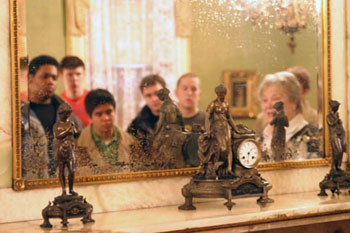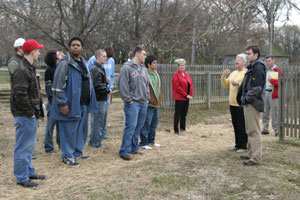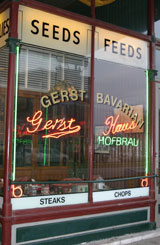 EVANSVILLE, Ind. – From dirt floors to gilded walls might not be the experience students expected studying German immigration into Indiana. But the stark contrast in homes is what Wabash College students experienced Monday as part of their German-American Experience tutorial class.
EVANSVILLE, Ind. – From dirt floors to gilded walls might not be the experience students expected studying German immigration into Indiana. But the stark contrast in homes is what Wabash College students experienced Monday as part of their German-American Experience tutorial class.
The Wabash men began the third day of their Immersion learning experience with a drive to New Harmony. The students took a more than 2-hour walking tour of the town and the historic New Harmony sites.
New Harmony began in 1814 as George Rapp’s desire to form a utopian society and await the coming of Jesus Christ. After 10 years of thriving and building more than 180 buildings, the Harmonites returned to Pennsylvania and sold the property to Robert Owen. The wealthy industrialist had similar ideas of a perfect society but instead of religion his utopia would be driven by education and culture. That experiment lasted only two years.
Students toured the town and saw some of the 40 structures which remain and learned its history from Jan Kahle, the state-owned site’s education director. Southern Indiana University now operates the museum while the state owns pieces of property throughout New Harmony.
 There are a few original cabins or reproductions from the very early 1800s and many with dirt floors. The Harmonite homes were far nice with more amenities.
There are a few original cabins or reproductions from the very early 1800s and many with dirt floors. The Harmonite homes were far nice with more amenities.
An afternoon trip into Evansville included an informal walking tour of the city’s historic riverfront area and a visit to the Reitz House Museum. John Augustus Reitz built the home in 1815. He and his ancestors failed and prospered in a number of businesses before becoming one of the area’s most successful and influential businessmen.
Many of the home’s original furnishings remain today. But the home is the showplace more than its furniture. The entrance way walls feature gold, elaborate lighting fixtures, wood carvings and heavy wooden doorways. The woodwork and other fixtures throughout are eye-popping examples of the luxury lifestyle of the 1800s into the last century.
A brief walking tour of the city’s west side with Evansville Reitz teacher Jon Carl preceded dinner at the Gerst Haus Bavarian Restaurant.
"Today was different for me because I was with people who had never been to Evansville before," said Evansville Reitz graduate and Wabash freshman Andrew Deig. "I have a different appreciation for the town and for what it has to offer. The study we’re taking in Dr. Redding’s class is a lot different than the study I took in high school from Mr. Carl. Dr. Redding’s class is more of the big picture and now I understand more how this history happened."
 Deig took the usual good-natured ribbing from classmates about being the big man in his home town, but the football player took the responsibility of being host seriously.
Deig took the usual good-natured ribbing from classmates about being the big man in his home town, but the football player took the responsibility of being host seriously.
"Whenever we go to another city in Indiana I’d say if somebody in our group was from there that they should know more about their local history than anyone else in the group," Deig said. "And that’s the way I feel. I’ve had a pretty good education from my teachers about Evansville history."
Deig was also willing to admit he’s becoming a fan of immersion learning.
"The immersion experience is definitely different," he said. "I thought it would be a lot more jam-packed but it’s really not, it’s more laid back. I was actually not looking forward to this trip at all, but it’s actually gone pretty well. I’ve had a good time so far and it’s been pretty fun."
The students leave Indiana Tuesday for an overnight trip to Cincinnati, a key port of entry for many German immigrants. The group will join up with Don Heinrich Tolzmann, who wrote the textbook for the class, and take a walking tour of the city’s Over-the-Rhine area. Their day will conclude Tuesday with dinner and a visit to Newport, Kentucky’s Hofbrauhaus. The Hofbrauhaus is a famed beer hall and restaurant in Munich, Germany.
Hewitt is Wabash College’s Director of New Media and Web Content Editor.
In photos:
Above right: Reitz Museum tour guide Carol Winslow and students admire an onyx mantle in a parlor. The photo is their reflection as they admire the artwork and fireplace.
Above left: The Wabash men hear New Harmony education coordinator Jan Kahle talk about a 1700s-era cabin.
Above right: The students ate Monday evening at the Gerst Haus Bavarian Restaurant, which once was a hardware store.
On homepage: Wabash men listen to Evansville Reitz High School teacher Jon Carl talk about the historic nature of the city's westside which has been heavily shaped and influenced by Germans.
For more information see: